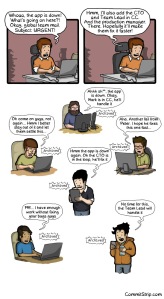
Rafael Nadal’s loss in the first men’s round of Wimbeldon 2013 was a shock to tennis enthusiasts around the globe, many of whom were disappointed and outraged at the star player’s premature defeat. Even if Nadal’s rugged Spanish looks had a role to play in inspiring these emotions (C’mon ladies, who are you fooling?), jokes apart, most people would regard him as an ‘expert’, ‘a top-ranked player’ and most importantly, a ‘favourite’. Yet, Nadal lost the match to Lukas Rosol, a 135-th rank player (Nadal is currently ranked world No.1). What sparked even more outrage was Roger Federer’s loss in the second round to Sergiy Stakhovsky, who was later labelled ‘The Roger Federer Slayer’ (The Independent, June 2013). A seven time Wimbledon champion, Federer was expected to get much further in the game, if not win the trophy itself. If asked to guess what affected the star’s performances, perhaps one would suggest that they were not in their best form during those matches, or maybe even that their opponent’s game improved.
Another explanation could be that the players experienced what is known as ‘choking under pressure’. Many individuals have faced instances of seemingly insurmountable obstacles in their lives, leading to stress and pressure. The final you have been preparing for and the penalty shootout which will win your team the cup, both have one thing in common- they each have a considerable reward at stake. For the student it means a stronger application to graduate school, for the soccer player it means a cup, money and approval from his/her team. It is in these instances of high stress that choking under pressure is highly prevalent, affecting performance negatively. There are a number of explanations for this phenomenon, one being the distraction theory (Baddeley, 2003) which posits that the worry and stress that accompanies pressure causes distraction, eventually leading to poor performance. The explicit monitoring theory, on the other hand, posits that in the face of pressure, individuals may direct step by step attention to the task, which disrupts their natural attention focus. This exercise of attention is dysfunctional, causing poor performance (Baumeister, 1984; Beilock & Carr, 2001).
While these theories are well cited in the literature, an interesting take on choking under pressure was proposed by researchers at Utrecht University – Erik Bijleveld, Ruud Custers & Henk Aarts (2011). They posit that subtle cues in the environment which indicate that a valuable incentive is at stake can lead to choking under pressure. This is based on the finding that on-going mental processes are disrupted when reward cues enter conscious awareness (Bijleveld, Custers & Aarts, 2011; Zedelius, Veling, & Aarts, 2011). This research was specifically conducted to suit the context of tennis tournaments as in some finals; trophies are prominently displayed near the court, within clear vicinity of the players. The presence of the trophy makes it a high incentive situation, thereby increasing the probability of the occurrence of choking under pressure. Their hypothesis was based on archived data of tennis finals between 2007-2009. Interestingly, they found that choking under pressure occurs for ‘favourites’ – players with high world rankings – rather than underdogs. This hypothesis was made based on previous literature, which shows that individuals who have enjoyed previous successes are more vulnerable to choking (Bijleveld, Custers,& Aarts, 2011; Zedelius, Veling, & Aarts, 2011). For example, research (Jordet, 2009) shows that soccer players are more likely to miss penalties after they gain ‘super star-status’.
Therefore, they found that in the case of tennis finals, favourites tend to choke under pressure when a subtle reward cue, associated with the large incentive at stake (the monetary incentive), is present in the finals environment. The study suggests that trophies kept by the court, within the favourite’s vicinity, trigger distracting thoughts which affect performance negatively, thereby leading to choking under pressure. However it is important to note that the reward cue doesn’t directly affect match outcomes- while it may lead to a more exciting match, it doesn’t necessarily predict the outcome directly. It would more likely result in a favourite not playing as well as ‘he/she always does’.
The study indicates that the simple presence of a subtle reward cue can nudge star tennis players’ performances in a particular direction. The findings from this study give us an in-depth understanding of the motivating (and de-motivating) power of incentives. A high stake incentive may be motivating to some, but may backfire for others, based on the situation. The effect that incentives have on us can be unconscious and when an incentive is large, it may affect our performance in unexpected ways. The Utrecht University study on choking suggests a possibility that may have previously been questioned by skeptics- factors in the external environment can significantly influence a players (‘favourites’ in this case) performance in the game.
To think that the invincible looking people in the images below can be victims of the human mind too.


References-
Baddeley, A. (2003). Working memory: Looking back and looking forward.Nature Reviews Neuroscience, 4, 829–839.
Baumeister, R.F. (1984). Choking under pressure: Self-consciousness and paradoxical effects of incentives on skillful performance. Journal of Personality and Social Psychology.46, 610–620.
Beilock, S. (2010). Choke: What the secrets of the brain reveal about getting it right when you have to. New York, NY: Simon and Schuster.
Bijleveld, E.,Custers, R. & Aarts,H. (2011) When favourites fail: Tournament trophies as reward cues in tennis finals, Journal of Sports Sciences, 29:13, 1463-1470
Zedelius, C.M., Veling, H., & Aarts, H. (2011). Boosting or choking – How conscious and unconscious reward processing modulate the active maintenance of goal-relevant information. Consciousness and Cognition 20, 355–362.










